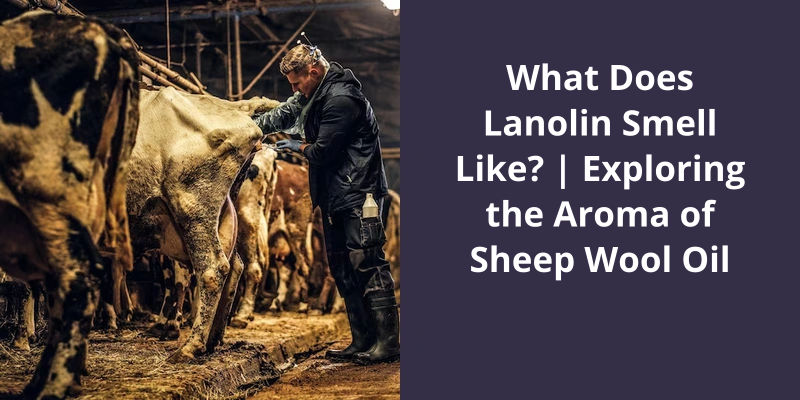Lanolin is known to have a unique smell that can be described as earthy, animal-like, and somewhat heavy. For some people, the scent might be similar to that of a wet wool sweater, as lanolin is indeed the greasy substance secreted by sheep to condition their wool. To others, it might give off an aroma that is faintly reminiscent of barnyards or pastures, given its natural animal source. It’s important to note that this distinct smell may not be appealing to everyone, although it isn’t necessarily unpleasant either. Overall, the smell of lanolin is complex and its interpretation could largely depend on individual sensory perception.

What Color Is Pure Lanolin?
It’s commonly used as an emollient, which helps to soothe and moisturize the skin. In it’s pure form, lanolin is often a pale yellow color. The exact shade can vary slightly depending on a number of factors, including the breed of sheep, the processing methods used to extract the lanolin from the wool, and any additives or impurities that may be present.
As it’s refined and purified, any impurities and unwanted coloration are removed, resulting in a purer, whiter lanolin. However, lanolin that’s been processed to this extent may no longer be considered “pure” by some standards, as it may have undergone chemical treatments or filtration that alter it’s natural properties.
For example, lanolin may be mixed with other emollients or oils to create a luxurious moisturizer that’s a smooth, creamy texture and a soft beige or ivory hue. Alternatively, lanolin may be mixed with pigments or dyes to create a product that matches a specific skin tone or color.
Regardless of it’s color, pure lanolin is highly valued for it’s moisturizing and protective properties. It’s a popular choice for use in skincare products such as creams, lotions, and balms, as well as in hair care products such as shampoos and conditioners. The natural emollient properties of lanolin help to soothe and moisturize dry or damaged skin and hair, while also providing a barrier against environmental irritants and pollution.
What Are the Benefits of Using Pure Lanolin in Skincare and Hair Care Products?
Pure lanolin is an excellent ingredient in skincare and hair care products because it hydrates, nourishes, and protects the skin and hair. Lanolin is a natural wax that’s secreted by sheep to protect their wool from the elements. It’s an excellent emollient that can penetrate deeply into the skin and hair to provide moisture and repair damage. In addition, it’s hypoallergenic, softens skin, prevents moisture loss, and soothes irritated skin.
Now that we’ve established that pure lanolin does indeed have a distinct odor and creates a water repellent barrier, it’s important to understand how it’s used and what alternatives are available.
Does Lanolin Have an Odor?
Lanolin, a wax-like substance derived from sheep wool, is appreciated for it’s moisturizing and protective properties. However, one of it’s characteristics that’s often debated is it’s smell. The truth is that pure lanolin does have a distinct odor, described as musky, fatty, or even sheep-like. This scent can be particularly strong in unpurified or unrefined products, such as lanolin straight from the sheeps wool or from low-quality lab extraction methods.
However, it’s important to note that not all lanolin-based products have the same smell. Many manufacturers refine and purify lanolin to remove impurities, which can reduce or completely eliminate the natural odor. Moreover, some lanolin-based products are scented with essential oils or fragrances that mask or complement the lanolins scent.
Because pure lanolin is hydrophobic, or water-repellent, it can trap dirt, sweat, or other substances that may cause unpleasant odors. This is why lanolin isn’t typically used in clothing or fabrics, as it can stain or leave residues that are hard to remove. However, some people still use lanolin in leather goods, shoe polish, or skincare, where the benefits outweigh the odor or staining risks.
How to Remove the Natural Odor of Lanolin
- Avoid using hot water when washing lanolin-containing items
- Use a mild detergent specifically designed for wool or lanolin-containing items
- Add a cup of white vinegar to the wash cycle to help neutralize the odor
- Hang lanolin-containing items out in the sun to naturally freshen them up
- Consider using a lanolin-specific soap or treatment to help remove the odor
- Avoid using fabric softeners or dryer sheets when drying lanolin-containing items
- Store lanolin-containing items in a dry, well-ventilated area to prevent odor buildup
Source: How to reduce the smell of lanolin?
While wool products have always been highly sought after due to their durability, warmth, and natural properties, they can sometimes come with a strong chemical smell that can be unpleasant and concerning. For many consumers, this unpleasant odor can be a source of confusion and worry, but it’s important to understand that it’s often the result of natural processes that occur during the production of wool garments. In this article, we will explore the unique properties of wool and the factors that can contribute to the chemical smell that’s often associated with wool coats.
What Is the Chemical Smell in Wool Coats?
However, the smell of wool coats can also be attributed to the chemicals used during manufacturing. These chemicals help to clean and process the wool, giving it a more uniform appearance and texture. Some of these chemicals can have a strong odor, and they may linger even after the final product has been finished. All of these factors can contribute to the lingering scent of wool coats.
This method uses sulfuric acid to remove any vegetable matter that may be caught in the wool fibers. While effective, the process can create a strong sulfuric odor that can be difficult to remove. This is why it’s important to thoroughly air out your wool coat before wearing it for the first time, as this can help to dissipate any chemical odors.
While natural dyes are available, they can be more expensive and less vibrant than their synthetic counterparts. Many manufacturers use synthetic dyes to achieve a wider range of colors and patterns, but these dyes can have a strong chemical odor. If youre sensitive to chemical smells, it’s a good idea to opt for wool products that use natural dyes instead.
If you pack your coat away in a damp or humid environment, it may start to develop a musty odor. Additionally, if your coat is stored near other fabrics or materials with strong scents, such as cleaning products or candles, it may absorb these odors over time. To keep your wool coat smelling fresh, store it in a cool, dry place with plenty of ventilation.
By taking these steps, you can enjoy the warmth and comfort of a wool coat without having to worry about any unpleasant odors.
The Process of Cleaning and Processing Wool for Manufacturing
The process of cleaning and processing wool involves various mechanical and chemical operations to remove impurities and prepare it for manufacturing. These processes include shearing, scouring, carding, and spinning, among others. They ensure that the wool is clean, soft, and suitable for further processing.
While lanolin is known for it’s moisturizing benefits, it’s important to be aware of potential side effects before incorporating it into your skincare routine. Some users may experience skin irritation, redness, and burning sensations. In rare cases, there may be more serious side effects such as changes in the skin texture or signs of infection. It’s always best to consult with a dermatologist before using new products to ensure they’re safe for your specific skin type.
What Are the Side Effects of Lanolin?
Lanolin is a natural substance produced by the sebaceous glands in sheeps wool. It’s commonly used in skincare products as a moisturizer and emollient. Although lanolin is generally considered safe, it can cause side effects in some individuals. These side effects are usually mild and go away on their own within a few days of stopping lanolin use.
In rare cases, lanolin can cause unusual changes in the skin, such as turning white, soft, or soggy from too much wetness. This can happen when lanolin is applied to the skin in excess or left on the skin for too long.
Another rare side effect of lanolin is the development of skin infections. Signs and symptoms of a skin infection include pain, swelling, redness, and the presence of pus or other fluids. If you suspect that you’ve a skin infection, seek medical attention right away.
Symptoms of an allergic reaction include hives, itching, swelling, difficulty breathing, and dizziness.
It’s important to note that lanolin isn’t recommended for use on infants skin, as they’re more susceptible to side effects and infections. If you’re pregnant or breastfeeding, it’s also important to consult with your healthcare provider before using products containing lanolin.
It’s always best to consult with your healthcare provider before using any new skincare product, especially if you’ve sensitive skin or a history of skin allergies.
Now that we’ve established that lanolin is obtained without causing harm to sheep, let’s take a closer look at this natural product and why it’s so beneficial for our skin.
Are Sheep Harmed to Make Lanolin?
As a natural product, lanolin is obtained from the wool of sheep, which means it isn’t synthesized artificially. Due to it’s unique properties, lanolin is widely used in cosmetic and medicinal products. However, as the demand for lanolin increases, there have been concerns about whether sheep are harmed in the production process.
It’s important to note that shearing a sheep is a common agricultural practice that isn’t harmful to the animal. As such, shearing is essential to their welfare.
What Is Lanolin and What Are It’s Properties?
Lanolin is a natural substance secreted by the sebaceous glands of sheep that helps to protect their wool from environmental damage. It’s commonly used in cosmetics and skin care products due to it’s moisturizing and emollient properties, which help to soothe and hydrate dry, chapped skin. Lanolin is also used as a lubricant in various industries, including pharmaceuticals and textiles. It’s unique chemical composition gives it the ability to bind with water molecules, making it an effective natural moisturizer.
Conclusion
In conclusion, the natural scent of lanolin is unique and difficult to replicate and is often the subject of poetic musings. It’s a representation of the natural world that’s captured in the wool of sheep and has come to symbolize purity and closeness to nature. The scent of lanolin is a reminder of our connection to the natural world and the importance of preserving the environment.





